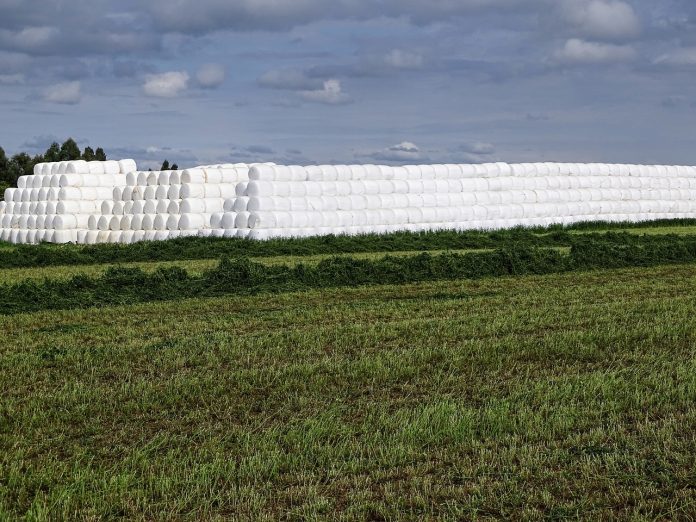February is here and it comes with a flood of hearts, flowers, chocolates and romance. It also brings weather that triggers maple syrup season and the ideal conditions for frost seeding pastures.
If your valentine is a pasture manager, I have the perfect gift idea ahead! Say “I love you” with the gift of clover seed! Instead of a bouquet of roses, consider a bag of red clover. Instead of fancy wine, consider an improved variety of white clover. Maybe just go ahead and get all of the above though, just to be safe.
Not convinced yet? Let me explain why February is a fantastic time to share the love of legumes.
Why now
The ideal time for frost seeding tends to be mid-February. When the water in the upper horizon of the soil freezes, the water expands, which leads to pressure that forces soil up and out during a freeze. Then when the water in the soil thaws, it takes up less space, and the soil settles back again.
The freezing, thawing and soil heaving cycles help work seed that is spread on the surface into the soil. Good seed-to-soil contact will help seedlings get a jump start on the growing season without the risk of disturbing soils in the early spring when conditions may be too wet to tread on. Broadcasting seed at this specific time is called “frost-seeding”.
Frost seeding is an effective and low input method for thickening up pasture and hay field stands (or even lawns) with a broadcast application of seed. It is a method that is most successful with varieties of red clover and white clover.
How to
Frost seeding can be implemented in both fields with and without livestock present. If livestock are in the field, hoof traffic can assist with seed-to-soil contact in combination with soil heaving. You can broadcast the seed by hand, with a hand crank or with a seed broadcaster on an ATV. Seed could also be aerially applied via plane or drone if the service is available to you.
Frost seeding rates vary depending on the type of forage seed you choose. Frost seeding isn’t just for legumes. Some grasses can successfully be frost-seeded as well. For best success, start with high quality seed and broadcast the seed during weather patterns where nighttime temperatures drop below freezing and daytime temperatures rise above freezing.
There are many situations where frost seeding legumes is advantageous. The practice can help remediate areas where bare ground is present. Whether the bare ground is a result of high-traffic, herbicide application, or soil disturbance, clover is likely to provide good cover to these areas in the spring. Soil coverage as soon as possible helps prevent weeds from establishing in these sensitive areas.
It is important to consider that some broadleaf herbicides may have residual impacts on the establishment of legumes. There may be a recommended timeframe to wait between treating for broadleaf weeds and adding legumes or forbs back into the pasture. That time frame could vary from a few weeks to several months. Be sure to fully read all labels, keep accurate application records, and follow any restrictions dictated on the label.
Legumes are beneficial additions to pastures and hayfields for their ability to form mutually beneficial relationships with nitrogen-fixing soil bacteria. These rhizobia fix atmospheric nitrogen into plant available nitrogen in the root zone around the legumes and thus benefits the other plants growing in the area. To ensure fixation occurs, purchase inoculated seed. Legumes also provide a greater percentage of digestible nutrients and proteins than most grasses, which improves the nutritional value of the pasture or hayfield.
Rates

Frost seeding is an economical way to gradually improve pasture conditions in combination with providing appropriate fertility and harvest practices. For both legumes and grasses, the recommended seeding rates are less than 10 pounds of seed per acre. In our area, we have access to improved varieties of clovers with rhizobia inoculant for $3 to $5 per lb. The impact of that investment could repay itself several times in the first year of growth.
If you are officially considering frost seeding now, note that the window for frost seeding typically spans from Feb. 1 to March 15. The recommended seeding rates for the forages that deliver good establishment through frost seeding are provided in the chart.
The ease of frost-seeding makes it appealing, but the seeding step alone isn’t all it takes for establishment to be successful.
It is important to provide time for frost-seeded plants to grow substantial and healthy roots and leaves before allowing animals to graze them. Legumes need adequate sunlight to thrive. It may be necessary to clip a pasture in the spring before grazing to allow light to get through the canopy of already-established plants. This allows the seedlings to get enough sunlight to be healthy, strong, and resilient to defoliation when grazing or haymaking begins.
Every farm has its own special traits that set it apart from others. Therefore, it may be beneficial to talk in more detail with a professional about your plans to improve the current status of your forage systems. Contact your local Extension Office for a free consultation and take the time to shop for good quality seed before the ideal day to plant it arrives.













